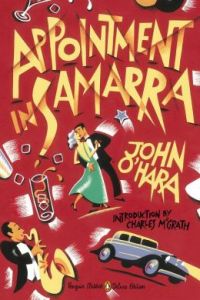‘Appointment in Samarra’ by John O’Hara (1934) – 251 pages
Have you ever taken such an active dislike of someone that you get an uncontrollable urge to severely embarrass that person in public? That is how Julian English, the protagonist of “Appointment in Samarra”, first gets into trouble.
“Why, he wondered, did he hate Harry Reilly? Why couldn’t he stand him? What was there about Reilly that caused him to say to himself: ‘If he starts one more of those moth-eaten stories I’ll throw this drink in his face.’ But he knew he would not throw this drink or any other drink in Harry Reilly’s face. Still it was fun to think about it.”
But later that night he does throw the drink in his face. This is only the first incident in the two-day downfall of Julian English.
The title ‘Appointment in Samarra’ sounds like a foreign thriller filled with adventure and intrigue, an exotic story of spies. Nothing could be further from the truth. Instead, as John Updike wrote in his introduction, this novel is “a picture of a man destroyed by drink and pride”. The novel takes place in the year 1930, a year after the stock market crashed and three years before the end of Prohibition.
Julian English is a successful young businessman in the fictional small town of Gibbsville, Pennsylvania. He is the director of the Cadillac dealership and is a member of the local country club.
“In a town the size of Gibbsville — 24,032, estimated 1930 census — the children of the rich live within two or three squares of the children of parents who are not rich, not even by Gibbsville standards. This makes for a spurious democracy, especially among boys, which may or may not be better than no democracy at all.”
He has a loving wife Caroline But Julian’s own worst enemy is himself. And alcohol. John O’Hara’s story here is a lot raunchier and lowdown than Fitzgerald or Hemingway, Julian has a couple of tacky sexual encounters on his way to the bottom. Perhaps these sleazy encounters were included to paint a real picture of the times, although they did ruffle the feathers of a lot of critics and readers.
According to Fran Lebowitz, the author John O’Hara is underrated, “because every single person who knew him hated him.” His personality was abrasive and unpleasant, but he managed to have over 200 stories published in the New Yorker. Many consider his short stories his greatest accomplishment, although five of his novels were turned into movies. He is known for his strong dialogue and insights into the night life of the socially ambitious. As opposed to other writers of his time, O’Hara wrote about the crude and nasty side of his characters. Lorin Stein writes in the New Yorker, “O’Hara’s tackiness is his great advantage over more respectable writers of his time.”
To find out what life was like in the United States in the 1920s and 1930s, during Prohibition and the Great Depression, read F. Scott Fitzgerald, Sinclair Lewis, John Steinbeck, and, yes, John O’Hara.

Posted by gaskella on January 9, 2014 at 9:06 PM
I must read some John O’Hara one day – I have ‘Butterfield 8’ on the shelves.
LikeLike
Posted by Anokatony on January 9, 2014 at 9:13 PM
Hi Gaskella,
You are in luck. ‘Butterfield 8’ is John O”ara’s wildest tackiest book that offended the most people. I read it back before I had a blog.
LikeLike
Posted by Annabel (gaskella) on January 10, 2014 at 11:11 AM
Looking forward to it already. Wild, tacky, offensive – all words that draw me to it.
LikeLike
Posted by Anokatony on January 11, 2014 at 9:43 PM
Hi Annabel,
Yes, it has everything. The movie ‘Butterfield 8’ starring Elizabeth Taylor was a watered down version of the novel but still good.
LikeLike
Posted by Kat on January 9, 2014 at 10:42 PM
Tony, thank you for writing about John O’Hara because I found this book at a Planned Parenthood Book sale last year and intended to read it, but as so often with the boxes of cheap books I find, I then forgot all about it. My husband thinks O’Hara is not worth reading, but I did enjoy Butterfield 8. Maybe his stuff hasn’t held up that well, but this one sounds pretty good. So let’s hope I can find the book now…
LikeLike
Posted by Anokatony on January 10, 2014 at 12:38 AM
Hi Kat,
Yes, there are a lot of different opinions on John O’Hara. The editors of the New Yorker must have liked him, since they published 200 of his stories. Five of his novels were made into movies. John Updike thoght he was good. Fran Lebowitz wrote ‘To me, O’Hara is the real Fitzgerald’. He was apparently an unlikeable person. I think Dawn Powell is a much superior writer and also Sinclair Lewis and F. Scott Fitzgerald and John Steinbeck.
LikeLike